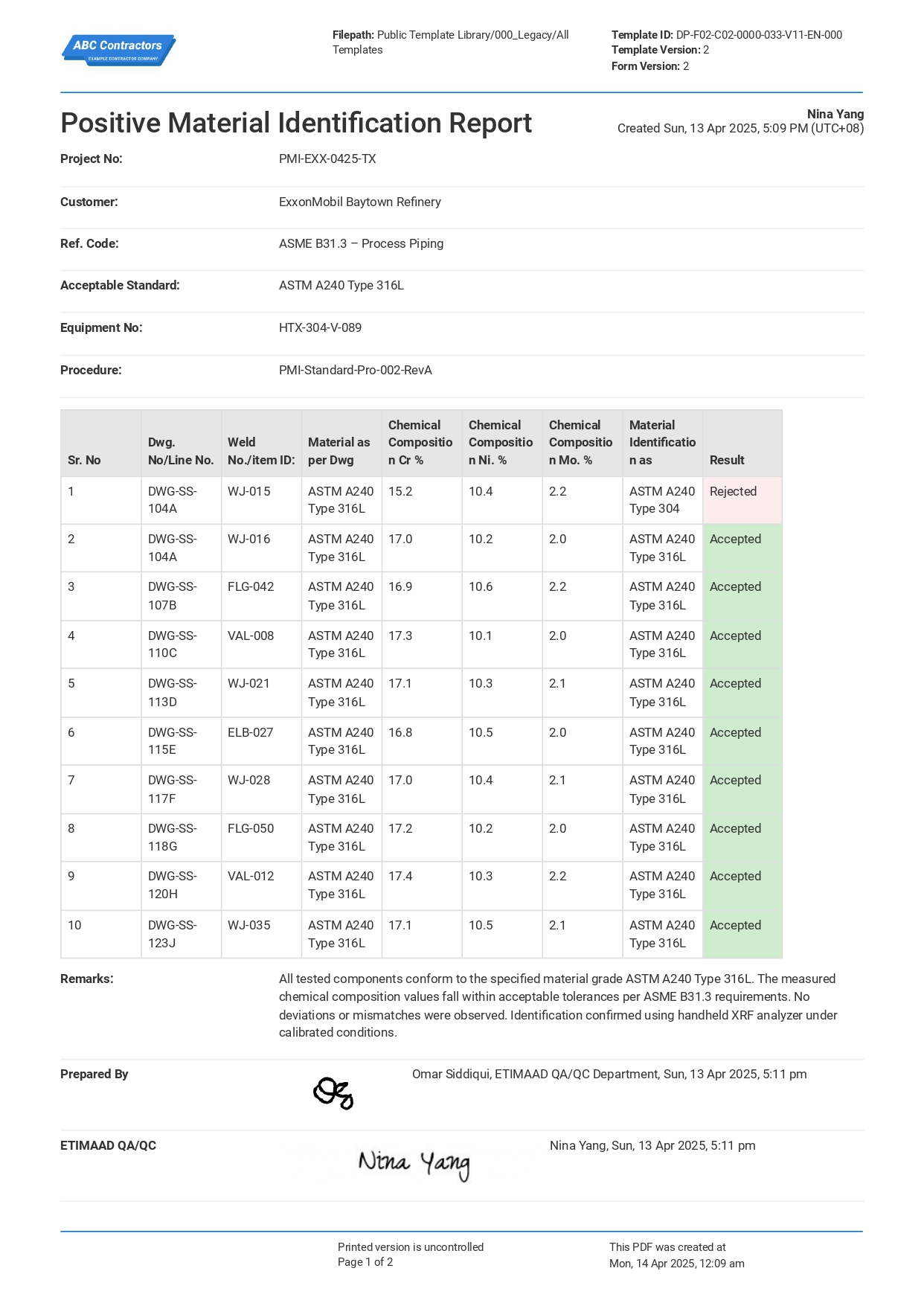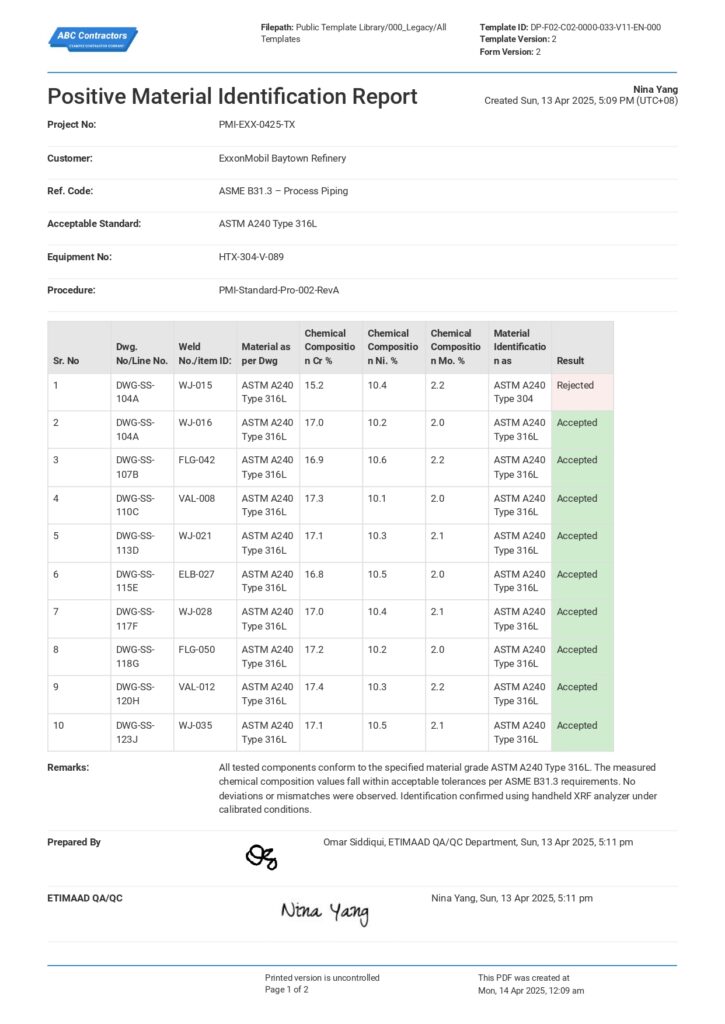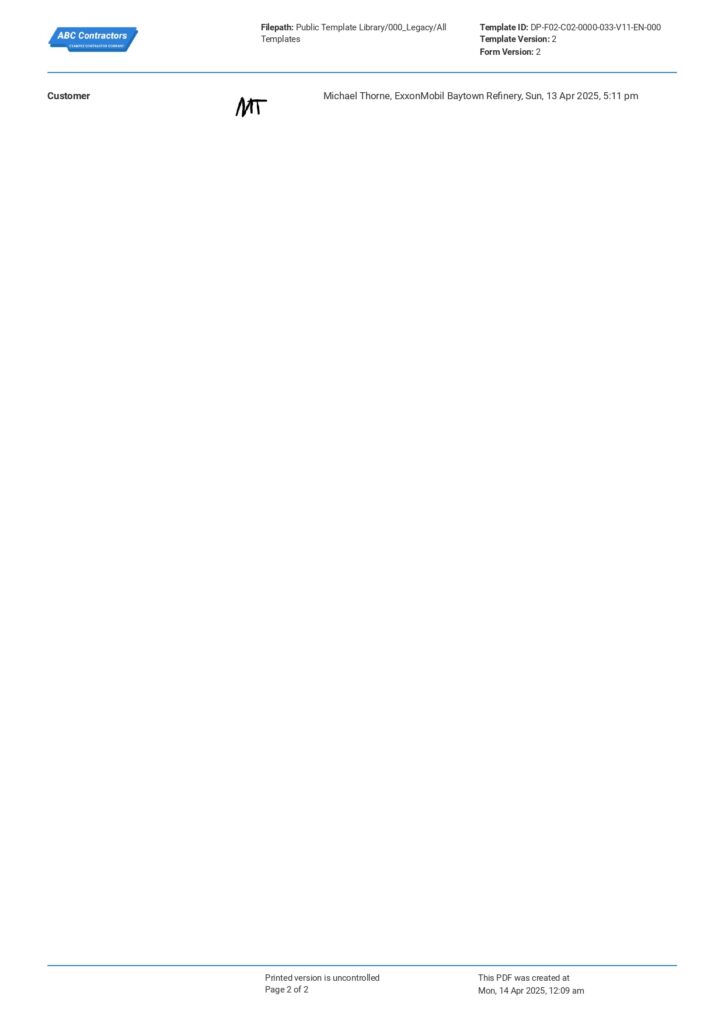Positive Material Identification Report Template
Start with a free 30-day trial. No credit card required.

~10,000 employees
~500 employees
~10 employees
~25,000 employees
~200 employees
~1,500 employees
~1,500 employees
What is a Positive Material Identification Report?
A positive material identification report is a record of the test results of Positive Material Identification (PMI), which is a type of nondestructive testing triggered based on risk to confirm if the material composition is correct—for the purpose of checking if there’s a mix-up or if the material conforms to the specifications set by standards and regulations. This method is highly applicable to industries where the chemical composition of the material matters, such as those in oil and gas, construction, and manufacturing. In most instances, if it is found that there is a discrepancy in the material, all materials have to be reviewed or returned to the supplier, which is time-consuming and costly. It is necessary for a company to have dependable documentation for these tests, as it drives the decision on these types of material issues.
Compare this Positive Material Identification Report format to paper-based forms created from Word, Excel or PDF
Use this Positive Material Identification Report template for free
When is Positive Material Identification used?
This test method is not the most common out of all the Non-Destructive Testing (NDT) methods, as it’s not an everyday occurrence that a company would require confirming the chemical composition of the material being used. However, Positive Material Identification is indispensable and necessary in critical situations. There are essentially two crucial scenarios when PMI is used:
1. Confirmation of material quality and safety
PMI confirms material quality by checking the chemical composition of metals and alloys that are found in pipelines or valves to reduce the risk of failure and to verify if they meet specified standards from various codes like ASME, ASTM, or API, depending on what’s required—but this is primarily important within the Boiler and Pressure Vessel Code (BPVC). Failure due to the wrong material used can be catastrophic, especially in the oil & gas industry, where using the wrong type of steel could result in chloride-induced corrosion.
2. Discrepancy in material marking or labeling
Mismarking can happen despite advanced and continually improving methods to confirm that the material supplied is correct. When a component arrives, it is standard procedure for any company to confirm the material label and certification. If a discrepancy is found, this is where positive material identification shines, in a sense, because it’s a non-destructive method that uses handheld devices, making it practical, as it is easier and faster to confirm whether you’re really using the right materials for your purposes.
How to conduct Positive Material Identification?
Given the timing and necessity of positive material identification and how it’s considered the fastest noninvasive testing, let’s look at the methods by which it’s being performed.
X-ray fluorescence analysis (XRF)
This is a rapid technique that analyzes the elemental composition of materials. The instrument which is the XRF analyzer is held at a 90o angle on a stable surface and when the trigger is pulled, it emits X-rays that excite the atoms in the material and emit fluorescent X-rays which the device will read and then display elemental breakdown to confirm chemical composition.
Optical emission spectrometry (OES)
This is also a rapid technique taking less than a minute. It applies a high-voltage electrical discharge to a sample, causing it to vaporize and emit light. The emitted light is then analyzed using a spectrometer, which separates the light into its constituent wavelengths, that allows the inspector to identify the composition.
When to Use XRF or OES for Positive Material Identification?
When it comes to choosing between the two—XRF or OES—it all boils down to usage. Both are fast and can identify material rapidly; however, XRF is more portable than OES. If the material to inspect doesn’t need carbon detection, then XRF is much better, as it gets the job done and is mobile. If you need post-weld analysis or full-grade confirmation along with tracing carbon, OES would be the preference for greater accuracy.
Performing Positive Material Identification (PMI) is highly effective when it’s critically important, such as when triggered by quality and safety concerns. It is also very important to have straightforward, structured documentation that’s just as practical as the positive material identification procedure itself. A well-built report that aligns with codes and international regulations would ensure greater trust in the soundness of the procedure performed.
Frequently Asked Questions
Why use this Positive Material Identification Report template?
Sitemate's Positive Material Identification Report template is already proven and trusted by thousands of oil and gas and construction companies because it’s practical and it works. It comes pre-built to align with quality inspection best practices, and is user-friendly for any worker.
Is this template compliant with ASME, ASTM and API standards?
Yes - this template is modeled to align with ASME B31.3,ASTM A240 and ISO 17025 and other local and international regulations widely used in Australia, the UK, New Zealand, and other regions. It's already used by certified contractors across different industries to either get or maintain certification status.
Can I edit this Positive Material Identification Report for my project or company?
Yes - the template is completely editable with easy drag-and-drop functionality. You can create thousands of potential document setups using different field types including tables, formulas, sketches, photos and more, to cater to any type of data capture, as well as add your company logo, custom headers and other important structure. All of this configuration is powered by Dashpivot's template builder.
What formats is this Positive Material Identification Report available in?
This template can be used across all devices - computer, mobile and tablet. This means you can edit and fill out forms on your computer, or access and complete reports on-site or off-site. Once filled out, any record in the system can be geneerated or exported as PDF or CSV, meaning you get the best of Word Doc, PDF and Excel, with the power of modern software.
Other popular templates you can use and edit for free

Material Inspection and Receiving Report
Track and record your material receipts and inspections with this on-the-go recording tool.

Liquid Penetrant Inspection Report
Easy-to-fill-out report form where you can also add a sketch of the material being tested.

Non-Destructive Testing Report
A smart reporting tool for general inspection offers the option to choose the NDT method.
This smart report was generated with Dashpivot software
Get a documentation system that's as fast as your critical testings. Upgrade to a highly reliable quality management software.
- Access, edit and complete Positive Material Identification Report from any device.
- Export and send your report as perfectly formatted PDF documents with your company logo.
- Store and manage your reports securely online, where they can be searched and found hassle-free.
- Invite team members or external parties to see, report and sign off on reports online.
Sitemate builds best-in-class software tools for built world companies.

